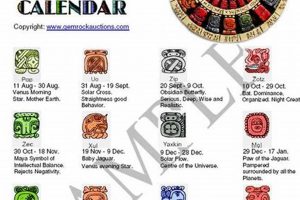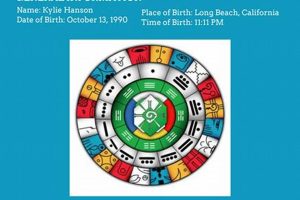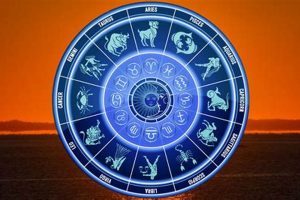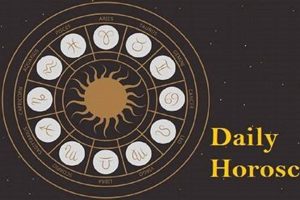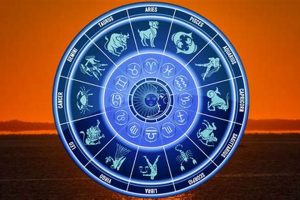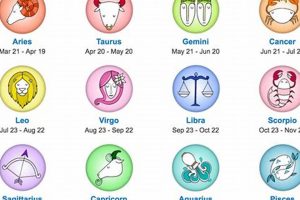Tools designed to interpret the ancient Mayan calendrical system often incorporate astrological elements, providing insights into personality traits, life cycles, and potential future influences. These resources typically require inputting a Gregorian calendar birthdate, which is then converted to corresponding Mayan dates and associated astrological glyphs, such as the day sign and the trecena. For example, a given birthdate might be associated with the day sign Imix and the trecena 1 Ajaw, each carrying specific symbolic meanings within Mayan cosmology.
Understanding the Mayan calendar system extends beyond mere date conversion. It offers a framework for understanding time as a cyclical process and recognizing the interconnectedness of individual lives within larger cosmic patterns. Rooted in meticulous astronomical observation and a profound spiritual worldview, the Mayan calendar provides a unique lens for self-reflection and understanding one’s place within the universe. This approach to timekeeping differs significantly from the linear perspective of the Gregorian calendar, offering a distinct perspective on personal and collective destinies.
This exploration will delve further into the intricacies of the Mayan calendar, its astrological associations, and the practical application of these concepts in contemporary life. Specific topics will include detailed explanations of the Tzolkin (sacred calendar), the Haab (civil calendar), the Calendar Round, and the Long Count, as well as the significance of individual glyphs and their combined interpretations.
Tips for Utilizing Mayan Calendar Astrology Resources
Effective engagement with Mayan calendar astrology tools requires careful consideration and understanding of the underlying principles. The following tips offer guidance for navigating these resources and interpreting the information provided.
Tip 1: Understand the Difference Between Calendars: Distinguish between the Tzolkin (sacred calendar), the Haab (civil calendar), and the Calendar Round. Each serves a different purpose and provides unique insights.
Tip 2: Research Day Sign Meanings: Explore the symbolism associated with each of the 20 day signs. These meanings provide the foundation for interpreting personal characteristics and life paths.
Tip 3: Consider the Trecena Influence: Each 13-day trecena carries its own energy and influences the day signs within it. Understanding the trecena provides additional context for interpretation.
Tip 4: Explore the Lords of the Night: These nine deities govern cycles of time and influence individual destinies. Researching their characteristics adds another layer of depth to the interpretation.
Tip 5: Consult Reputable Sources: Seek out resources that offer accurate and nuanced information about the Mayan calendar and its astrological associations. Avoid superficial interpretations.
Tip 6: Avoid Deterministic Interpretations: While the Mayan calendar offers valuable insights, avoid viewing its interpretations as fixed predictions. Instead, consider them as potential influences and opportunities for growth.
By following these guidelines, individuals can gain a deeper appreciation for the complexity and richness of Mayan calendar astrology. This approach facilitates a more meaningful exploration of personal identity and potential life paths.
These insights provide a foundation for further exploration of Mayan cosmology and its relevance to contemporary life. The concluding section will offer a synthesis of key concepts and suggest further avenues for research.
1. Birthdate Input
Birthdate input serves as the foundational element for any Mayan calendar astrology calculation. Accuracy in this initial step is paramount, as even slight discrepancies can significantly alter the resulting Mayan date conversions and subsequent astrological interpretations. The Gregorian calendar datecomprising day, month, and yearprovides the necessary data for the calculator to perform the complex conversion to the Mayan Long Count, Tzolkin, and Haab calendar systems. This conversion process acts as a bridge between contemporary timekeeping and the ancient Mayan worldview, enabling access to the associated astrological insights. For instance, a birthdate of July 26, 1987, when processed through the calculator, might correspond to a Tzolkin date of 8 Kimi and a Haab date of 7 Pax, each carrying specific symbolic weight within the Mayan system. This initial input, therefore, triggers a chain of calculations that unlock the potential astrological meanings encoded within the Mayan calendar.
The precision required for birthdate input underscores the interconnectedness of time and individual destiny within Mayan cosmology. The Mayan calendar system, unlike the linear Gregorian calendar, emphasizes cyclical patterns and the influence of specific energetic combinations associated with given dates. Understanding this interconnectedness highlights the importance of accurate birthdate entry. Incorrect data prevents access to the correct corresponding Mayan dates and therefore yields inaccurate astrological readings. This emphasizes the crucial role of birthdate input as the initiating factor in aligning an individual with their unique Mayan astrological profile. Moreover, exploration of birthdate-derived Mayan astrological information can provide insight into personality traits, life purpose, and potential challenges, offering a distinct lens for self-discovery.
In summary, accurate birthdate input is essential for generating meaningful interpretations within Mayan calendar astrology. This initial step sets the stage for the conversion process, aligning the individual with their corresponding Mayan dates and associated astrological glyphs. The precision required underscores the Mayan worldview’s emphasis on the interconnectedness of time and personal destiny. Subsequently, exploring this personalized astrological information offers a valuable tool for self-reflection and understanding one’s place within the larger cosmic cycles. This understanding forms a critical foundation for any further exploration of Mayan cosmology and its potential insights into individual lives.
2. Calendar Conversion
Calendar conversion forms the crucial bridge between the familiar Gregorian calendar and the intricate Mayan calendrical system within the context of Mayan calendar astrology calculators. This process translates a Gregorian birthdate into corresponding Mayan dates, enabling the subsequent astrological interpretations. Without accurate conversion, accessing the rich tapestry of Mayan astrological insights remains impossible. This section explores the key facets of this conversion process.
- The Long Count
The Long Count serves as the backbone of Mayan chronology, measuring time from a mythical creation date. It provides a linear timeline against which other Mayan calendar cycles operate. Converting a Gregorian date to the Long Count establishes a fixed point within the vast expanse of Mayan time. For example, a birthdate might correspond to a specific Long Count number, placing the individual within the broader historical and cosmological narrative of the Mayan calendar. This Long Count position becomes essential for calculating other cyclical calendar dates.
- Tzolkin Calculation
The Tzolkin, or sacred calendar, consists of a 260-day cycle formed by the interweaving of 13 numbered days and 20 named days. Calendar conversion algorithms determine an individual’s Tzolkin day sign and its position within the trecena, the 13-day period influencing the day sign’s energy. This calculation, based on the Long Count position, unveils the individual’s connection to specific energies and characteristics associated with their Tzolkin date. For instance, a Tzolkin date of 1 Ik might suggest new beginnings and creative potential.
- Haab Correlation
The Haab, or civil calendar, consists of 365 days divided into 18 months of 20 days each, with a five-day period called Wayeb’. Calendar conversion determines the corresponding Haab date, revealing the individual’s connection to the agricultural and seasonal cycles. This provides an additional layer of astrological interpretation, linking the individual to specific periods of the year and their associated energies. A Haab date of 8 Cumku might connect an individual to the energies of abundance and harvest.
- Synchronization of Cycles
The Calendar Round, a 52-year cycle formed by the combined cycles of the Tzolkin and Haab, plays a significant role in Mayan astrology. Calendar conversion ensures the correct synchronization of these cycles, accurately pinpointing the individual’s position within this larger timeframe. This synchronization allows for a more nuanced astrological interpretation, as the combined energies of the Tzolkin and Haab create a unique signature for each Calendar Round date. This complete picture provides deeper astrological insights than either calendar alone could offer.
These interconnected elements of calendar conversion within Mayan calendar astrology calculators ensure accurate and meaningful interpretations. The conversion process provides the foundation for understanding an individual’s placement within the complex cycles of Mayan time, connecting them to the associated astrological energies and influences. This foundational process unlocks the rich symbolic language of the Mayan calendar and allows for its application in contemporary contexts.
3. Tzolkin Calculation
Tzolkin calculation is integral to the functionality of any Mayan calendar astrology calculator. The Tzolkin, a 260-day sacred calendar, forms the core of Mayan divination and provides essential insights into personality, destiny, and daily energies. A Mayan calendar astrology calculator must accurately determine an individual’s Tzolkin birth date based on their Gregorian calendar birthdate. This requires a complex algorithm that accounts for the cyclical nature of the Tzolkin and its relationship to the Gregorian calendar. The resulting Tzolkin date, composed of a number (1-13) and a day sign (one of 20 unique glyphs), provides the foundation for astrological interpretation. For example, a birthdate calculated as 4 Ajaw signifies specific energies and characteristics associated with that combination, influencing personality traits and life path.
The importance of accurate Tzolkin calculation lies in its ability to unlock the rich symbolism embedded within the Mayan calendrical system. Each of the 260 possible Tzolkin dates carries unique energetic qualities derived from the combined meanings of the number and the day sign. These qualities are believed to influence an individual’s strengths, weaknesses, and life purpose. A calculator’s accuracy in determining the Tzolkin birth date ensures the individual receives the correct astrological information. Without this precision, the resulting interpretations could be misleading or entirely inaccurate. Furthermore, understanding one’s Tzolkin birth date provides a framework for understanding daily energies, offering guidance for decision-making and navigating life’s challenges. For instance, consulting the Tzolkin calendar can offer insight into auspicious days for specific activities or potential challenges to anticipate.
In summary, Tzolkin calculation acts as a critical component within a Mayan calendar astrology calculator. The precision of this calculation is paramount for accessing accurate astrological insights, serving as the basis for understanding individual characteristics and life path potentials. This detailed calculation translates complex calendrical systems into practical tools for self-discovery and navigating daily life. Furthermore, understanding the Tzolkin calculation process allows for deeper appreciation of the richness and complexity of Mayan cosmology and its application in modern contexts. This knowledge provides a more informed perspective when utilizing such calculators and interpreting their results.
4. Haab Correlation
Haab correlation plays a crucial role within Mayan calendar astrology calculators, providing a link between the 365-day solar year and the broader Mayan cosmological framework. The Haab, also known as the civil calendar, consists of 18 months of 20 days each, followed by a five-day period called Wayeb’. Understanding the Haab’s influence is essential for interpreting astrological information derived from these calculators. This correlation provides additional context for the individual’s placement within the yearly cycle and adds another layer of meaning to astrological interpretations.
- Agricultural Significance
The Haab’s close alignment with the solar year reflects its agricultural roots. Each month corresponds to specific agricultural activities and seasonal changes. A Mayan calendar astrology calculator, by correlating a birthdate with a Haab date, can reveal potential connections to particular agricultural cycles and their associated energies. For example, a birthdate falling within the month of Mol could suggest a connection to the energies of gathering and preparation. This link to the natural world adds a practical dimension to astrological interpretations.
- Wayeb’s Influence
The five-day Wayeb’ period, considered a time of introspection and transition, holds unique significance within the Haab. Birthdates falling within Wayeb’ often carry specific astrological connotations related to liminality and spiritual reflection. A calculator must accurately account for Wayeb’ to provide complete and nuanced astrological insights. This period’s unique energetic qualities can significantly influence interpretations, adding a layer of complexity beyond the typical 18-month cycle.
- Interaction with the Tzolkin
The Haab correlation, when combined with the Tzolkin calculation, creates the Calendar Round, a 52-year cycle. Mayan calendar astrology calculators use this combined information to provide a more comprehensive astrological profile. The interplay between the Haab and Tzolkin energies adds depth and nuance to the interpretations. For instance, a specific Haab date combined with a specific Tzolkin date will yield a unique meaning different from either date considered in isolation.
- Contemporary Applications
While rooted in ancient practices, Haab correlation within Mayan calendar astrology calculators finds relevance in contemporary contexts. By understanding the Haab’s influence, individuals gain insights into their connection with natural cycles and potential energetic influences. This information can be applied to personal growth, decision-making, and understanding life patterns. The Haab’s cyclical nature offers a framework for understanding recurring themes and potential challenges throughout life.
In conclusion, Haab correlation within Mayan calendar astrology calculators provides a vital link to the agricultural and seasonal cycles embedded within Mayan cosmology. This correlation adds depth and complexity to astrological interpretations, allowing for a more nuanced understanding of individual characteristics and life paths. The Haab’s influence, when considered alongside the Tzolkin and the larger Calendar Round, provides a powerful tool for self-discovery and navigating the complexities of life. By recognizing the Haab’s significance, individuals can gain a deeper appreciation for the richness of Mayan astrology and its continuing relevance in the present day.
5. Astrological Glyphs
Astrological glyphs function as the symbolic language within Mayan calendar astrology calculators, representing core components such as day signs, trecena numbers, and Haab months. These glyphs, visually distinct and rich in meaning, translate calculated dates into interpretable astrological information. A calculator, after performing date conversions, identifies corresponding glyphs. For instance, a calculated Tzolkin date of 7 Manik corresponds to the glyph for Manik, representing the deer and symbolizing artistic talent and intuition. This glyph, combined with the number 7, creates a specific energetic signature, forming the basis for further astrological interpretation. Without these glyphs, the calculated numerical data would lack symbolic meaning and practical application within the astrological framework.
Understanding the symbolism of individual glyphs proves essential for utilizing Mayan calendar astrology calculators effectively. Each glyph carries specific connotations, representing deities, natural forces, or abstract concepts. The glyph Imix, for example, symbolizes the primal waters of creation and represents potential and nurturing energy. A calculator might display Imix alongside other calculated glyphs, providing a layered interpretation. Knowledge of these symbolic meanings unlocks the narrative potential encoded within the calculated data, allowing for meaningful self-reflection and exploration of potential life paths. Moreover, recognizing the interplay between different glyphs within a combined reading adds depth and nuance to the interpretation, revealing intricate connections between various aspects of personality and destiny. This nuanced understanding allows for a more holistic interpretation of the calculated astrological information.
In summary, astrological glyphs within Mayan calendar astrology calculators serve as the essential link between numerical calculation and symbolic interpretation. These glyphs, rich in meaning and visually distinct, translate complex calendrical data into accessible astrological insights. Understanding their symbolism allows for practical application of this information, providing a framework for self-discovery and understanding one’s place within the Mayan cosmological framework. This knowledge empowers individuals to engage with the calculator’s output in a meaningful way, moving beyond mere data points to a richer understanding of personal narratives and potentials.
6. Interpretation Generation
Interpretation generation represents the culmination of the computational processes within a Mayan calendar astrology calculator. This crucial stage transforms raw calendrical dataTzolkin day signs, Haab positions, and associated glyphsinto meaningful narratives regarding personality traits, life paths, and potential destinies. Interpretation generation distinguishes a simple calendar converter from a true astrological tool, providing users with applicable insights derived from complex calculations. This section explores the key facets of this interpretive process.
- Synthesizing Glyphic Meanings
Interpretation generation begins with synthesizing the meanings of the calculated glyphs. Each glyph, representing a day sign, number, or Haab month, carries specific symbolic weight. The interpretation engine combines these individual meanings to create a cohesive narrative. For instance, a Tzolkin day sign of Kan, representing the seed and associated with growth and new beginnings, combined with a Haab month of Pop, associated with leadership and community, might suggest an individual with a natural inclination towards initiating community projects or fostering growth within groups.
- Contextualizing within the Calendar Round
The Calendar Round, the 52-year cycle formed by the intersection of the Tzolkin and Haab calendars, provides essential context for interpretation generation. The calculator considers the combined influence of both calendars, recognizing that a specific Tzolkin day sign manifests differently depending on its position within the Haab year. This nuanced approach acknowledges the cyclical nature of Mayan time and ensures a more accurate and comprehensive interpretation than considering either calendar in isolation.
- Incorporating the Lords of the Night
Many Mayan calendar astrology calculators incorporate the influence of the nine Lords of the Night, deities governing cycles of time within Mayan cosmology. These Lords add another layer of interpretive depth, influencing the energies associated with specific periods. The calculator considers which Lord governs the individual’s birth date, integrating its associated characteristics into the overall interpretation. For example, the influence of G9, the ninth Lord of the Night associated with completion and transformation, might suggest an individual prone to periods of profound change and growth.
- Presenting Accessible Narratives
Effective interpretation generation lies in presenting complex calculations in an accessible narrative format. The calculator translates raw data into understandable language, offering insights into potential strengths, weaknesses, and life purpose. This translation requires careful consideration of the target audience and a balance between accuracy and clarity. The goal remains to empower users with actionable insights, not overwhelm them with technical jargon or ambiguous pronouncements.
These facets of interpretation generation highlight the crucial role this process plays within Mayan calendar astrology calculators. By synthesizing symbolic meanings, contextualizing within cyclical calendars, incorporating relevant deities, and presenting accessible narratives, these calculators transform complex computations into usable tools for self-discovery. Interpretation generation provides the bridge between ancient calendrical systems and contemporary applications, offering a unique lens through which to explore personal narratives and potential destinies. The effectiveness of this process ultimately determines the value and practical application of the entire Mayan calendar astrology calculator system.
7. Personal Insights
Mayan calendar astrology calculators offer a unique pathway to personal insights, utilizing complex calculations based on the ancient Mayan calendrical system. These calculators translate birthdates into corresponding Mayan dates and associated astrological glyphs, providing a framework for understanding individual characteristics, life purpose, and potential challenges. The following facets explore the specific types of personal insights obtainable through these calculators.
- Personality Traits
Mayan calendar astrology calculators can illuminate inherent personality traits by analyzing the energies associated with an individual’s Tzolkin day sign and Haab month. For example, a person born on a Men day might exhibit strong leadership qualities, while a birthdate in the month of Zip may indicate a focus on learning and intellectual pursuits. These insights can offer self-awareness, aiding personal development and relationship dynamics.
- Life Path and Purpose
The calculated Mayan astrological profile can suggest potential life paths and overall purpose. The interplay between the Tzolkin and Haab, combined with the influence of the Lords of the Night, paints a picture of an individual’s inherent strengths and potential challenges. This information can guide career choices, creative pursuits, and spiritual exploration. For example, a specific combination of glyphs might suggest a talent for healing or a calling towards artistic expression, providing direction for life choices.
- Relationships and Compatibility
Comparing Mayan astrological profiles can offer insights into relationship dynamics and potential compatibility between individuals. By analyzing the energetic interactions between different day signs and Haab months, the calculator can highlight potential areas of harmony or conflict. This information can be applied to romantic relationships, familial connections, and professional partnerships, promoting understanding and effective communication. Understanding these dynamics can help navigate relationship challenges and foster stronger connections.
- Spiritual Growth and Development
Mayan calendar astrology, with its emphasis on cyclical time and interconnectedness, can provide a framework for spiritual growth and development. Understanding one’s place within the larger cosmic cycles, as indicated by the Mayan calendar calculations, can offer a deeper understanding of life’s purpose and the nature of reality. This perspective can facilitate self-reflection, mindfulness, and connection to a broader spiritual context, guiding individuals towards greater self-awareness and inner peace. For instance, recognizing recurring patterns within one’s Mayan astrological profile can highlight areas for personal growth and karmic lessons.
These facets of personal insight demonstrate the depth and breadth of information accessible through Mayan calendar astrology calculators. By translating complex calculations into accessible narratives, these tools offer valuable opportunities for self-discovery, promoting understanding of individual characteristics, potential life paths, and the interconnectedness of all things. The insights derived from these calculators provide a unique framework for personal and spiritual development, empowering individuals to navigate life’s challenges and embrace their unique potentials within the context of Mayan cosmology. This understanding facilitates a deeper appreciation for the ancient wisdom embedded within the Mayan calendar and its continuing relevance in contemporary life.
Frequently Asked Questions
This section addresses common inquiries regarding Mayan calendar astrology calculators, aiming to clarify their function and dispel potential misconceptions.
Question 1: How does one determine their Mayan astrological sign using a calculator?
Accurate birthdate entry into a reputable Mayan calendar astrology calculator initiates the process. The calculator converts the Gregorian birthdate into its Mayan calendar equivalents, identifying the corresponding Tzolkin day sign, which represents the individual’s primary Mayan astrological sign. Additionally, the calculator determines the Haab date and associated glyphs, providing a more comprehensive astrological profile.
Question 2: Do these calculators provide definitive predictions of the future?
Mayan calendar astrology calculators offer potential insights into personality traits, life paths, and recurring cycles, not concrete predictions. They provide a framework for understanding potential influences and opportunities rather than forecasting fixed outcomes.
Question 3: What is the significance of the Calendar Round in these calculations?
The Calendar Round, a 52-year cycle formed by the synchronization of the Tzolkin and Haab calendars, provides a broader context for interpretation. A specific Tzolkin day sign combined with a particular Haab date creates a unique energetic signature within the Calendar Round, yielding a more nuanced understanding than either calendar alone.
Question 4: How do the Lords of the Night influence interpretations?
The nine Lords of the Night govern cycles of time within Mayan cosmology. Calculators often incorporate these influences, adding another layer of interpretation. Each Lord imbues specific energies and characteristics into the associated periods, affecting the overall astrological profile.
Question 5: Are online Mayan calendar astrology calculators reliable?
Reliability varies significantly among online resources. Seek calculators developed by reputable sources with demonstrated expertise in Mayan calendrics and astrology. Scrutinize the methodology employed and avoid calculators that offer overly simplistic or generalized interpretations.
Question 6: How does Mayan astrology differ from other astrological systems?
Mayan astrology emphasizes cyclical time and interconnectedness, contrasting with the linear perspective common in Western astrology. Its focus on the Tzolkin, Haab, and Calendar Round, along with the influence of deities like the Lords of the Night, distinguishes it from other systems. Mayan astrology offers a unique lens through which to understand personal narratives and connections to the cosmos.
Understanding these core concepts allows for a more informed and nuanced approach to utilizing Mayan calendar astrology calculators. These tools, when used responsibly, can provide valuable insights into personal characteristics and life paths within the framework of ancient Mayan cosmology.
Exploring further resources and reputable scholarly works will enhance comprehension of this complex and fascinating system.
Conclusion
Mayan calendar astrology calculators offer a unique lens through which to explore individual characteristics and potential life paths. These tools, based on the intricate Mayan calendrical system, convert Gregorian birthdates into corresponding Mayan dates, revealing connections to Tzolkin day signs, Haab months, and associated glyphs. Understanding the symbolism and interplay of these elements provides a framework for interpreting potential influences related to personality, relationships, and spiritual development. The accuracy and depth of these interpretations rely heavily on the calculator’s underlying algorithms and the user’s understanding of Mayan cosmology. Effective utilization requires careful consideration of the cyclical nature of Mayan time and avoidance of deterministic interpretations. These calculators serve as valuable tools for self-reflection, not predictive instruments.
The enduring fascination with the Mayan calendar and its astrological associations underscores a timeless human desire to understand individual destinies and connections to the cosmos. Further exploration of Mayan cosmology and its intricate calendrical systems promises deeper insights into the human experience. Continued research and responsible application of these ancient tools offer potential for enhanced self-awareness and a more profound understanding of one’s place within the intricate tapestry of time and existence. The Mayan calendar, far from a relic of the past, continues to offer a rich framework for exploring the ongoing human journey of self-discovery.


